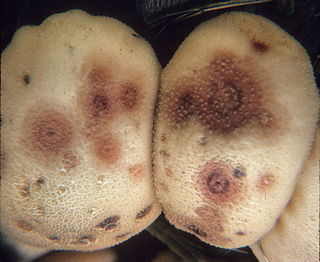
Malassezia is a genus of fungi.

The Hypocreales are an order of fungi within the class Sordariomycetes. In 2008, it was estimated that it contained some 237 genera, and 2647 species in seven families. Since then, a considerable number of further taxa have been identified, including an additional family, the Stachybotryaceae. Wijayawardene et al. in 2020 added more families and genera to the order. According to the Catalog of Life, As of April 2021 the Hypocreales contains 6 families, 137 genera, and 1411 species. Hyde et al. (2020a) listed 14 families under Hypocreales, while, Wijayawardene et al. (2022) accepted 15 families in the order, where Cylindriaceae was additionally added. Earlier, Hyde et al. (2020a) had placed Cylindriaceae in class Xylariomycetidae. Samarakoon et al. (2022) agreed. Hence, Cylindriaceae should have been excluded from Hypocreales and placed in Xylariomycetidae. Xiao et al. (2022) recently introduced a new family Polycephalomycetaceae to Hypocreales.

The Fungi of Australia form an enormous and phenomenally diverse group, a huge range of freshwater, marine and terrestrial habitats with many ecological roles, for example as saprobes, parasites and mutualistic symbionts of algae, animals and plants, and as agents of biodeterioration. Where plants produce, and animals consume, the fungi recycle, and as such they ensure the sustainability of ecosystems.

Acremonium is a genus of fungi in the family Hypocreaceae. It used to be known as Cephalosporium.
Thecaphora is a genus of basidiomycote fungus which contains several species of plant pathogens. The widespread genus contained about 57 species in 2008. and held 61 species in 2020.

Bipolaris is a genus of fungi belonging to the family Pleosporaceae. It was circumscribed by mycologist Robert A. Shoemaker in 1959.
Paraphaeosphaeria is a genus of fungi in the Didymosphaeriaceae family. The genus has 23 species found in Europe and North America. Anamorph forms are found in the genus Paraconiothyrium. The genus was circumscribed by O.E. Eriksson in 1967.

Noosia is a fungal genus in the division Ascomycota. The genus is monotypic, containing the single anamorphic species Noosia banksiae. The fungus is associated with brown leaf spots on the wallum banksia, an Australian shrub of the family Proteaceae. The conidia of the fungus are dimorphic. They are initially spherical, smooth and somewhat hyaline; later they become fusoid to ellipsoidal, brown, and covered in small warts. The generic name Noosia refers to the town Noosa, where the type collection was made, in Noosa National Park; the specific epithet refers to the generic name of the host plant.
Yelsemia is a genus of smut fungi in the family Melanotaeniaceae, containing four species.

André Aptroot is a Dutch mycologist and lichenologist. His primary research focus is on biodiversity, particularly tropical lichens, encompassing systematics, floristic surveys, and taxonomic reviews. A prolific researcher, he has published more than 500 scientific papers and described hundreds of new fungal and lichen species.

Teratosphaeriaceae is a family of fungi in the order Mycosphaerellales.

Kálmán Géza Vánky was a Hungarian mycologist with Swedish and Hungarian citizenship, who lived in Germany. He was considered to be the worldwide authority on the subject of smut fungi and has dominated the taxonomic study of Ustilaginomycetes for at least the past four decades.
Ross Ewen Beever was a New Zealand geneticist and mycologist.
Apinisia keratinophila, formerly Myriodontium keratinophilum, is a fungus widespread in nature, most abundantly found in keratin-rich environments such as feathers, nails and hair. Despite its ability to colonize keratinous surfaces of human body, the species has been known to be non-pathogenic in man and is phylogentically distant to other human pathogenic species, such as anthropophilic dermatophytes. However, its occasional isolation from clinical specimens along with its keratinolytic properties suggest the possibility it may contribute to disease.

Hohenbuehelia petaloides, commonly known as the leaflike oyster or the shoehorn oyster mushroom, is a species of agaric fungus belonging to the family Pleurotaceae. The fruit bodies have pale to brown funnel-shaped caps with decurrent gills and are considered edible. The species has a cosmopolitan distribution and is found near the decaying wood it feeds on.

Epicoccum is a genus of fungi belonging to the family Didymellaceae.
Macalpinomyces is a fungus genus in the Ustilaginaceae family.
Penicillium tealii is a species of fungus in the genus Penicillium. It was discovered at Rowlands Creek near Uki in far northeastern New South Wales in April 2021 on the body of a dead spider. Citizen scientist Donovan Teal accidentally discovered the fungus while collecting samples of insect-eating fungi and it was subsequently named after him.

Neopestalotiopsis is a genus of plant pathogens in the family Sporocadaceae.














